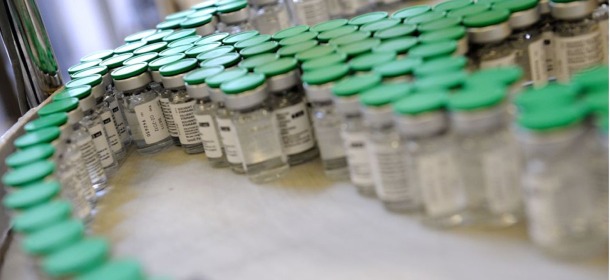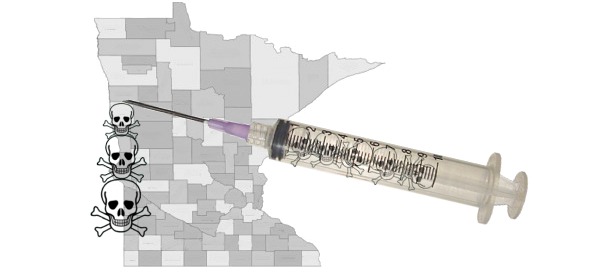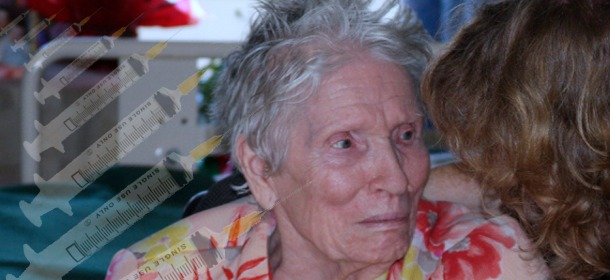Featured
Flu Vax Causes 5.5 Times More Respiratory Infections
The utter absurdity of vaccination ‘science’ is revealed in this study. It claims a flu vaccine results in less disease risk because it causes antibodies to develop, in spite of not reducing the likelihood of contracting the disease and also resulting in 5.5 times more incidents of similar diseases!

Vaccine Vials, by Sanofi Pasteur, Vaccine Profiteer
by Heidi Stevenson
Would you be interested in a vaccination that results in more than 5 times as much illness? If you take the seasonal influenza vaccination, that’s what you’re doing. The seasonal trivalent flu vaccine results in 5.5 times more incidents of respiratory illness, according to a study published in Clinical Infectious Diseases.
The study is particularly noteworthy because it was a double-blind placebo-controlled trial—and the researchers used saline solution, a genuinely inactive placebo, as a standin for the trivalent flu vaccine. Most vaccine trials utilize active placebos, which are substances that include ingredients used in the vaccines, making the studies meaningless—though this fact is almost never revealed in the writeups.
Subjects were followed for an average of 272 days. The active influenza vaccine adminstered was Sanofi Pasteur’s Vaxigrip. The trial included children aged 6-15 years. 69 were given Vaxgrip and 46 received the saline placebo. Results were reported in terms of episodes per 1,000 person years of follow up.
With regard to effectiveness against influenza, the authors wrote:
There was no statistically significant difference in the risk of confirmed seasonal influenza infection between recipients of TIV [trivalent influenza inactivated vaccine] or placebo.
The flu vaccine provided no benefit!
The authors tried to cover that by adding:
TIV recipients had significantly lower risk of seasonal influenza infection based on
serologic evidence.
In other words, the authors are trying to suggest that, in spite of the fact that vaccine recipients suffered as much genuine influenza as those who’d received a placebo, they still benefited because of “serologic evidence”. This “serologic evidence” consists of antibodies produced as a result of the vaccine, which is the standard method of determining a vaccine’s effectiveness.
In other words, a vaccine’s effectiveness is not determined by whether it prevents disease, but rather by whether it causes antibodies to be produced!
But the story is even worse than this. The study also demonstrated that the vaccine resulted in recipients having 5.5 times more respiratory illness. Here’s a partial breakdown of their results:
| Vaccinated | Placebo (saline) | |
| Any Seasonal Influenza | 58 | 88 |
| H1N1 (Swine Flu ‘Pandemic’) | 58 | 0 |
| Total Influenza Cases | 116 | 88 |
| Noninfluenza Viruses | ||
| Rhinovirus (common cold) | 230 | 59 |
| Coxsackie/Echovirus | 160 | 0 |
| Other Respiratory Viruses | 97 | 29 |
| Total Other Viruses | 487 | 88 |
As you can see, even though the authors claim that there was no distinction in cases of influenza between the subjects who received a vaccine and those who received the placebo, the reality seems to be quite different: There were a total of 116 influenza cases in the vaccinated group and 88 in the placebo group.
The authors play with statistics in this study by using assumptions about whether people actually had diseases, because there were many reported instances that couldn’t be verified. They came up with a relative risk of 4.4. In any case, relative risk is actually a meaningless statistic here, because it requires that exposure to the causative agent be known, which it clearly wasn’t in this study.
I prefer a simpler, more straightforward—and, I believe, more honest—approach of simply comparing the numbers of cases of disease. Doing that, we get 487 ÷ 88, which tells us that those who were vaccinated were 5.5 times more likely to contract a confirmed respiratory illness!
Now, let’s take a look at the other respiratory illnesses that people were more likely to contract as a result of being vaccinated for influenza. The rhinovirus is the common cold, so it isn’t a big deal. However, coxsackievirus and echovirus are quite different. Both of them are known to cause meningitis, paralysis, hepatitis, and heart disorders. This is not common, but the same thing is true of poliovirus. It also causes a usually minor respiratory illness, but in rare cases can result in much the same harm that coxsackievirus and echovirus can.
It is, therefore, reasonable to suggest that the rate of severe crippling diseases may also be increased by the influenza vaccine, and potentially by any vaccine against a respiratory illness.
Implications
This study’s implications are quite serious. The authors suggest:
Receipt of TIV could increase influenza immunity at the expense of reduced immunity to
noninfluenza respiratory viruses, by some unknown biological mechanism. Alternatively, our results could be explained by temporary nonspecific immunity after influenza virus infection, through the cell-mediated response or, more likely, the innate immune response to infection.
In other words, the act of injecting antigens probably damages the innate cell-mediated immune response, the part of the immune system that protects without the need of resorting to development of antibodies. They go on to state:
The phenomenon of virus interference has been well known in virology for >60 years.
The interference of vaccinations with the innate cell-mediated immune response is well known! The authors go on to cite several sources supporting this fact.
In summary, this study demonstrates:
- Influenza vaccines provide no benefit.
- Influenza vaccines cause a hugely increased number of respiratory illnesses.
- Influenza vaccines—and very likely other vaccines—harm the innate cell-mediated immune response, which results in a significant increase in infectious disease incidents.
Nonetheless, our agencies of health destruction, such as the US’s alphabet soup of FDA, CDC, and NIH, the UK’s NHS, MHRA, and DOH, Australia’s ANPHA, and Canada’s Health Canada, plus the international WHO and massive foundations such as the Gates Foundation and GAVI—these and so many more routinely lie about the reality of vaccinations. They use fear tactics and lies to promote the profiteering of Big Pharma and Big Medicine at the expense of the populace, and worse, of our children.
The reality of all these agencies is that, though they may have been created for the purpose of benefiting our health, they’ve been coopted by Big Pharma and Big Medicine, who have managed to buy their way into them. The result is that these agencies now actively promote, and even enforce, the use of products and methods whose first purpose is to make profits. If that means the public’s health must suffer … apparently, it’s a small price to pay when it doesn’t affect the bottom line.
Sources:
- Increased Risk of Noninfluenza Respiratory Virus Infections Associated With Receipt of Inactivated Influenza Vaccine; Clinical Infectious Diseases; Benjamin J. Cowling, Vicky J. Fang, Hiroshi Nishiura,
Kwok-Hung Chan, Sophia Ng, Dennis K. M.lp, Susan S. Chiu, Gabriel M. Leung} and J. S. Malik Peir; DOI: 10.1093/cid/cis307
Tagged big pharma, Clinical Infectious Diseases, conventional medicine, flu vaccine infectious disease, flu vaccine no benefit, flu vaccine respiratory disease, flu vaccine study, Increased Risk of Noninfluenza Respiratory Virus Infections Associated With Receipt of Inactivated Influenza Vaccine, influenza vaccine, influenza vaccine effectivness, influenza vaccine infectious disease, influenza vaccine respiratory disease, influenza vaccine study, pseudo-science, vaccine, vaccines, vaxigrip, vaxigrip effectiveness, vaxigrip sanofi, vaxigrip sanofi pasteur














Pingback: Study: Flu Vaccine Causes 5.5 Times More Respiratory Infections – A True Vaccinated vs. Unvaccinated Study | Health Impact News
Pingback: NEW STUDY SHOWS FLU VACCINE MAKES YOU 5.5 TIMES MORE LIKELY TO CONTRACT RESPIRATORY ILLNESSES | The Liberty Beat
Pingback: Flu Vaccine Causes 5.5 Times More Respiratory Infections – Waking Times : Waking Times
Pingback: Le vaccin contre la grippe provoque 5,5 fois plus d’infections respiratoires | Sortir du chaos et de l'illusion
Pingback: Le vaccin contre la grippe provoque 5,5 fois plus d’infections respiratoires | Héritage Ancestral
Pingback: Indiana School Offers Free School Supplies in Exchange for Vaccinations Dark Politricks
Pingback: Indiana School Offers Free School Supplies in Exchange for Vaccinations
Pingback: Indiana School Offers Free School Supplies in Exchange for Vaccinations | Nwo Report